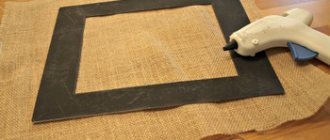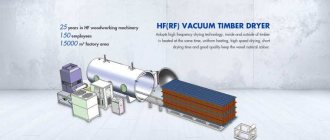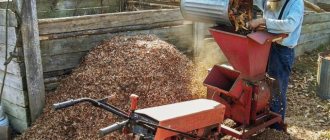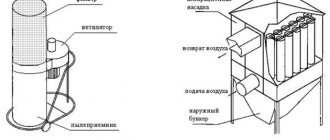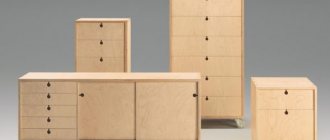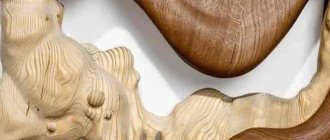Wood moisture concept
The percentage ratio of the weight of the liquid contained to the weight of completely dry wood of a certain volume is called absolute humidity. The percentage of the mass of water removed (determined by two weighings) to the original weight of the wood is called relative humidity.
The degree of suitability for use is determined taking into account the relative humidity indicator. The value indicates the readiness of the material for gluing and drying; with a value above 30%, there is a danger of developing a fungal infection.
Depending on the indicator, wood is divided into categories:
- wet - with a relative humidity of more than 23%;
- semi-dry – within the range from 18 to 23%;
- dry – with a humidity value from 6 to 18%.
Drying wood in natural conditions
With this method of removing moisture, a drying chamber for lumber is not used; the liquid evaporates under the influence of atmospheric air. Dry the material under a canopy located in a draft. The sun's rays unevenly heat the outer and inner layers of wood, which leads to the appearance of deformations and cracks.
If the site does not have a drying chamber for lumber, an attic, a ventilated shed, or an equipped shed are well suited for drying. The material is stored in a stack; the first layer must be placed on stands with a height of at least 50 cm made of any durable material. Rows of lumber are laid with dried slats, all subsequent boards and logs are placed above the previous blanks to create vertical air wells.
Logs sawn lengthwise and finished boards are laid with the inside facing up to reduce the size of the deformation. For the same purpose, a stack of wood is pressed from above with a heavy load. Due to the formation of cracking at the ends of the workpiece when drying the material, select the length of the workpiece to be 20-25 cm longer than the intended part.
The ends of the lumber are carefully treated with oil-based paint, drying oil or hot bitumen to prevent cracks. Before stacking, the log trunks are cleared of bark to reduce the likelihood of wood beetles breeding. Removing moisture from wood naturally is considered an economical method.
Why is it so important to dry wood?
This is a question many novice builders ask themselves when faced with the need to process building material before use. If you decide to make a mini wood dryer at home with your own hands, then you should definitely familiarize yourself with the following theoretical information, which will not make you give up in the event of the slightest failure.
So, furniture made from damp wood will very soon become deformed, dry out and become covered with cracks. If during the construction process a material is used that has not been dried in advance, then the damp beams will eventually lead the structure to the side, and cracks approximately the width of a palm will appear on the wooden walls. We should also not forget that mold can grow in damp wood: this is why it is so important to dry the wood before using it for construction.
Solar wood dryer
The second method, the cost of which quickly pays off, is drying chambers for lumber. The manufacturing drawings are quite simple; you just need to understand the operating principle of such a device. The chamber is an assembled plywood or metal container, the roof of which is made of transparent materials.
The size of the glazed roof surface is calculated depending on the total horizontal area of all lumber laid for drying. The area of the transparent coating should be one tenth of the total surface of the boards. The roof of the building is made pitched, the amount of slope depends on the geographical location of the area. In cold northern regions, where the sun does not rise high above the horizon, the roof slope is made steep. The southern sun warms up the gently sloping surfaces well.
Do-it-yourself dehydrator for meat and fish
A dryer for meat and fish can be easily made from a plastic container. For this you will need:
- fan;
- plastic container equipped with a lid;
- steel rods with a cross section of 5 mm or studs with threads, washers and nuts;
- pipe cut or coupling.
The entire process of making a dehydrator for drying fish, meat and drying other products from a plastic container is demonstrated in the video:
It’s easy to assemble a dehydrator for fish, meat, vegetables, fruits and other products from scrap materials: plywood, boxes, a refrigerator. Various working old fans are suitable for blowing. In each case, you will, of course, need to think over a way to secure them, but the economic costs will be reduced. In small installations, you can use a fan from a computer, having previously provided the required supply voltage. If you automate the dryer, then in terms of functionality it will be able to compete with factory analogues. When drying meat and fish, it is imperative to prevent flies from entering the interior of the installation so that they do not spoil the products.
How to make a drying chamber for lumber?
The frame of the building is made of metal or timber treated with an antiseptic under pressure. The lining of the walls and floor of the chamber is made of moisture-resistant materials, the fences are insulated with mineral wool or hard foam boards. The internal surfaces of the walls are treated with water-repellent compounds, aluminum powder is applied to them, and then painted black.
Fresh air blowers should not contain blades made of plastic, fusible materials. If the drying chamber for lumber is not used constantly, then the room is used for drying herbs, vegetables, berries or a seasonal greenhouse. After laying all the wooden blanks for drying, a distance of about 30-40 cm should remain between the stack and the wall on all sides.
Basic equipment for dryers
Whatever type of forced wood drying chamber is used, standard groups of equipment are allocated for all.
Transportation equipment is designed for loading and unloading logs or boards into the drying room. Includes machines and mechanical devices for storing workpieces in a stack or package, and carries out raising and lowering of lumber.
The thermal equipment of the chamber serves to raise the temperature of the internal air in the chamber and consists of many systems that determine the interconnected work of producing and transferring heat. These include heat exchange tanks, heaters, pipes for the passage of steam or hot water, devices for removing condensate, shut-off valves and control devices.
The fuel is gas and liquid fuel. For small volumes of work, a drying chamber for wood-burning lumber is equipped. The coolant is saturated steam, water, gas obtained from combustion of the furnace, and organic fillers of the system that have a high boiling point. Electric heaters are widely used, where current energy is converted into a thermal component.
Circulation equipment is designed for the organized movement of air masses in the drying chamber. The elements of the system are fans, injectors and joint installations of these elements. To increase the efficiency of wood drying, automation of lumber drying chambers is used.
Which heat source should you choose?
Have you decided to make infrared dryers for wood yourself? Are you sure that this is the best option for this design? It might be worth starting with a look at the main heat sources used in wood dryers:
- hot steam - next to the dryer there is a container with water that heats up;
- hot smoke - near the structure there is a wood-burning stove;
- electric current - electric charges pass well through wet wood;
- radiant heat - supplied from special heating devices;
- heated pipes - heat is removed from hot water pipes.
Also, today it is quite common to use a high-frequency electromagnetic field as a power source for a dryer, but it will be extremely difficult to implement such a method at home, so we did not mention it in the main list, but keep it in mind.
Drying chamber fence
To isolate the wood from the effects of the environment, a chamber fence is installed, which consists of a floor, ceiling, walls and intermediate partitions. Requirements for partitions:
- should not allow steam to pass through;
- fences must have low thermal conductivity;
- must have a long service life.
Fences are made separately from various building materials or can be prefabricated with a set of standard metal elements.
The first type of cameras has a longer operating life, but has a longer commissioning time, which is not always justified. Prefabricated metal frames are installed quickly, they are equipped with control and thermal devices, but the steel is subject to the destructive effects of wet and thermal conditions.
Low or high temperature for drying?
It is worth understanding that the answer will directly depend on the type of wood that you want to use for drying. Some building materials are best treated gradually at low temperatures, while others are treated as quickly as possible. Also, do not forget that low-temperature regimes can be divided into the following categories:
- forced - the material becomes brittle, the color darkens significantly;
- normal – the strength of the wood decreases slightly, the color changes;
- soft - the wood completely retains its properties and does not change color.
Each of these categories fits a specific case. For example, to decorate walls it is not at all necessary to use wood with good strength, but its color is of great importance. But for load-bearing beams it is best to use wood that has gone through the stage of soft processing, otherwise the entire structure will simply collapse.
But high-temperature processing is characterized by two drying stages. The first stage is characterized by a decrease in the moisture content of the feedstock to 20%, after which the wood cools down properly and is subjected to heat treatment again, but to a level from zero to five percent. This technology is most often used in the construction of secondary structures that are not of particular importance on the farm.
Making a drying chamber yourself
Private developers dry wood in their yard; for this purpose, they install a drying chamber for lumber with their own hands. Its installation will require a large room, a heat source and a device for distributing air between drying packages of wooden blanks.
You can, of course, purchase second-hand lumber drying chambers, but the degree of wear cannot always be determined correctly; it is much more profitable to arrange a room for drying wood yourself. This is an opportunity to get excellent results at a low cost.
What to consider when building a dryer?
To make it easier to understand how to make a wood dryer with your own hands, we recommend that you familiarize yourself with the basic wood drying modes that are used in modern dryers. There are quite a lot of them, since wood of various species requires special processing. When choosing a material, the following factors must be considered:
- indicator of starting and final humidity;
- quality category of raw materials used;
- features of a wood dryer;
- dimensions of lumber;
- wood species
If we classify wood dryers by type of processing, they can be low-temperature or high-temperature. In the first case, the primary operation is carried out at an air temperature that does not exceed 100 degrees Celsius.
Construction stages
You will need material for the frame, usually metal racks from a corner or channel; a wooden beam is used after careful treatment with an antiseptic. Metal sheets, moisture-resistant plywood panels, and profiled steel are used as wall coverings. Thermal insulation is carried out using mineral moisture-resistant wool and polystyrene foam.
Before construction begins, the location of one dryer or several is determined, which serves as a plan for constructing a concrete foundation. The foundation is made for the stability of the structure and uniform distribution of the load on the ground. If a ready-made railway container is taken for the camera, then four columnar foundations are made for the corners of the car.
The metal frame is assembled using welding or bolted connections. When installing, check the verticality and horizontality with a building level, trying to strictly observe the geometric dimensions. After securing the frame in the installation position, they begin to cover the outer walls, simultaneously inserting doors and ventilation windows.
The thermal insulation layer of the floor, walls and ceiling must be at least 12-15 cm, the base is insulated from moisture with rolled material. After this, the chamber is checked for leaks. To lay the first layer, stationary supports made of metal or wood are installed. Install a heat source, usually a powerful fan heater, position it so that the direction of the hot air is parallel to the lying boards.
Drying wood is a necessary condition for obtaining quality raw materials. Building a house or making fillings for openings from damp lumber is fraught with distortions and damage to integrity. In order to carry out work with wood without problems, you need to take seriously the removal of excess moisture from the material.
Aluminum wood dryer
If you decide to build a separate room for the dryer, we strongly recommend that you take a closer look at the aluminum option, since such a design will last a really long time, and building it will not be particularly difficult. The frame is made of aluminum profile, after which metal sheets are screwed on the outside. Also, the outside of the structure must be insulated so that the cold aluminum walls do not lower the air temperature inside the dryer - this will save a significant amount on fuel. The thickness of the insulation must be at least 15 centimeters. Well, the floor needs to be covered with roofing felt, especially if you place the dryer on cold ground. As an additional insulation, a thick layer of wood shavings is sometimes poured under the roofing felt and compacted well.

